Brisbane, the capital of Queensland, is a large city located on the Brisbane River, on the east coast of Australia, in Queensland's South-East corner.
Brisbane has a subtropical climate and a unique and diverse history.
The Turrbal and Yuggera People
Before the British settlement of Brisbane in 1825, the Turrbal Aboriginal Clan lived on the land around Brisbane, which they called Meanjin.
Many different groups of Aboriginal people other than the Turrbal and the Yuggera clans inhabited the
wider area around Brisbane before European settlement. Such as the Jagera people on Stradbroke Island, the Nunukul people, the Joondaburri of Bribie Island and the Ningy Ningy of Moreton Bay.
The area that would later be called York’s Hollow, after the Duke of York (Barrambin), was an important
camping and ceremonial place for various Aboriginal groups.
The site of Roma Street railway station was a very important hunting and gathering ground for Aboriginal people, with its abundance of water and wildlife.
A book by author Libby Connors, called "Warrior", reflects on the life of the Aboriginal resistance fighter, Dundalli, who was born about 1820, in the Blackall Ranges, north of the Glasshouse Mountains. Dundalli was
involved in a decade-long resistance to white colonisation in the Brisbane area. He was hung publicly in Brisbane in 1855.
 |
| Image of a woodcut depicting a conflict between aboriginal tribes in Brisbane, 1854, State Library of QLD |
 |
| Three men photographed inside a studio, Brisbane, circa 1868, State Library of QLD |
 |
| Aboriginal people of Brisbane, Moreton Bay (Journal des Museum Godeffroy, pt 10, plate 1), |
European Exploration and Settlement
Matthew Flinders explored Moreton Bay, which is 14 kilometres from central Brisbane, during his
expedition from Port Jackson north to Hervey Bay, in 1799, onboard the “Norfolk”. Flinders landed at Woody Point in Redcliffe, and also at Coochiemudlo Island and Pumicestone Passage, whilst he searched for a river in the southern part of Moreton Bay.
 |
| Captain Matthew Flinders who visited Moreton Bay in 1799, Telegraph (Brisbane, Qld. : 1872 - 1947), Wednesday 6 August 1924 |
The New South Wales Governor Thomas Brisbane was petitioned by free settlers of Sydney, to find a place to send the worst convicts. The area that is now called Brisbane was chosen for this purpose.
 |
| Sir Thomas Makdougall Brisbane, Baronet, British soldier and astronomical observer, Telegraph (Brisbane, Qld. : 1872 - 1947), Wednesday 6 August 1924 |
Shipwrecked Convicts
The Surveyor General John Oxley left Sydney on 23 October 1823, to investigate various locations for the convict settlement. As he entered Point Skirmish by Moreton Bay, he saw a group of men who he thought had lighter skin than most, Aboriginal people.
It turned out that these men were shipwrecked convicts, who had lived with an Aboriginal tribe for seven months.
 |
| Surveyor General John Oxley, returning from Port Curtis, explored Moreton Bay, QLD, in 1823, Telegraph (Brisbane, Qld. : 1872 - 1947), Wednesday 6 August 1924 |
The men, Thomas Pamphlett, Richard Parsons and John Finnegan, in March 1823, were sailing to fetch cedar from the Illawarra region, when they became lost at sea for days, before finally landing on Moreton Island, QLD. The group were rescued by explorer John Oxley, on the
HMS Mermaid, on 29 November 1823, which made them the first European people to live in the Brisbane area.
Whilst Oxley was exploring Moreton Bay he noticed a large group of Aboriginal people, who fished in the
river and who used the local kangaroos, possums and goannas as food sources.
Penal Settlement
This first penal settlement of the fledgeling Queensland colony was initially located at Redcliffe, established in 1824, under the command of Lieutenant Henry Miller and named after Sir Thomas Makdougall Brisbane, the sixth Governor of New South Wales, from 1821 to 1825. Lieutenant Henry Miller arrived on the brig
Amity, with soldiers, their families and 30 convicts.
In August 1825, Major Lockyer set sail for Moreton Bay in the cutter
Mermaid, following the instructions of Governor Brisbane to explore the Brisbane River as far as he could go, "with prudence", and report on the animals, birds, minerals and "nature, disposition, complexion etc. of the natives".
Lockyer found the stream that carries his name and the Stanley River and found coal near present-day Ipswich. Lockyer named Redbank after the colour of the soil.
 |
| Major E Lockyer, Telegraph (Brisbane, Qld. : 1872 - 1947), Saturday 25 June 1938 |
Relocated
In 1825, the penal settlement was moved to the banks of the Brisbane River (North Quay), the current Brisbane CBD. This was a more elevated position, with more water sources.
During Captain Patrick Logan's time as commandant of the Moreton Bay Penal Settlement from 1826, the convict population increased from 77 to over 1,000.
 |
| Capt. Patrick Logan. Painting: Mitchell Library, State Library of NSW |
At North Quay, the
convicts were set to work, clothed in their leather hats and jackets marked with the word "Felon", to build the first stone buildings, like the Colonial Stores building and a windmill.
The windmill was built for grinding flour and convicts were put upon a treadmill to drive the windmill. As recorded by the Quaker Missionary, James Backhouse, some of these undernourished men were left on that treadmill for
fourteen hours at one time.
 |
| The Old Windmill, Brisbane, QLD, Sydney Mail (NSW : 1912 - 1938), Wednesday 8 October 1930 |
Soldiers at Moreton Bay lived in tents until early 1826, when slab barracks were built at North Quay, on the northern side of today's Queen Street. Logan also set about building a gaol, a hospital, timber yard, and a government store. A two-storey Military Barracks to house the soldiers was not built until 1831, which was located where the Old Treasury Building now stands.
 |
| The first Houses of Parliament in Queen-street, originally the Military and Convict Barracks. Brisbane Courier (Qld. : 1864 - 1933), Monday 28 July 1924 |
The Convict Hospital was built in 1827. This building was later used as the hospital for Brisbane Town.
 |
| First Brisbane Hospital. Built as convict hospital (1827-1839). Used until 1879, Week (Brisbane, Qld. : 1876 - 1934), Wednesday 25 April 1934 |
Logan was generally hated by the convict population, for his strict discipline and brutal punishments. He is mentioned in the Australian folk ballad, "Moreton Bay". Logan was murdered by Aboriginal people in 1830.
The construction of the Old windmill was instigated by Logan, as was the Commissariat Store, which was used as a Government Store from 1829-1961 and built of local stone in 1828-9 by convicts.
 |
| Early drawing of a section of the town of Brisbane, Queensland including the Convict Hospital, 1835 |
A Harsh Place
The Brisbane Town superintendent of convicts, Peter Beauclerk Spicer, compiled a journal which provided a snapshot of daily life in Brisbane Town in 1828. One excerpt concerned the murder of John Carroll.
“Died this day: Foreman John Carroll, via Sir Godfrey Webster 2 – killed by Thomas Allen and Thomas Matthews”.
One of the murderers, Thomas Matthews, said of the Morton bay penal colony, as he stepped up to the gallows:
“If you go to Moreton Bay, (said the culprit,) you are ruined beyond redemption. You are either flogged to death or worked to death. I have known many bright men murdered – completely murdered by the ill-usage of overseers, constables, and those above them. Take warning by me – take warning – never run from your road gangs or iron gangs. If may perhaps send you to Moreton Bay, and then you are a lost man. The last time I was flogged was for stealing a few grains of wheat. I received a hundred severe lashes. Oh, fellow prisoners, avoid Moreton Bay”.
 |
| Windmill from Wickham Terrace, Brisbane, ca. 1885. State Library of QLD |
The convict, John Sterry Baker, was sent to Moreton Bay in 1825, after being transported from England for theft. In January 1828 he escaped the penal colony and was close to staving when a group of Aboriginal people found him. Believing him to be a tribal member named, Boraltchou, returned from the dead, they took him in. He lived with the Aboriginal people for 14 years, before returning to Moreton Bay. However, he found that the penal colony had been decommissioned. Eventually, Baker was sent to Sydney, where he is put to work as an interpreter for Aboriginal people.
Convict Era Ends
 |
| Early drawing of a section of the town of Brisbane, Queensland including the Convict Hospital, 1835. State Library of QLD |
In 1831 Moreton Bay settlement population reaches 1241, including 1066 convicts.
Between 1831 and 1838, the convict population of Moreton Bay deceased by 75%.
In 1837, the steamer, the James Watt, steered by explorer Andrew Petrie and his family, entered Moreton Bay. Andrew Petrie (builder and stonemason), later becomes clerk of government works. In
the following year, free settlement started. Andrew Petrie's son, John Petrie will become Brisbane's first mayor and his other son Tom writes about early Brisbane (see below).
 |
| One of the oldest pictures of Brisbane extant. It probably dates between,1830 and 1835. On the waterfront may be seen the old Colonial stores, now portion of the Government stores, which building was erected by convict labor.Daily Standard (Brisbane, Qld. : 1912 - 1936), Wednesday 6 August 1924 |
The convict era came to an end in 1839 and Brisbane went forward with three separate settlements: North Brisbane, Kangaroo Point and South Brisbane. However, there was little money to develop Brisbane in the 1840s and less than 1000 people living in the three settlements.
The Moreton Bay penal settlement closed in 1842 and free settlement to the Moreton Bay area began with Brisbane Town as the centre.
The former convict barracks were rented out as accommodation to free settlers after the convicts left.
 |
| Map of Brisbane drawn by C. F. Gerler. This basic map has a numbered list of forty-eight locations in the bottom right corner. The list corresponds to places and residences on the map. The locations are represented by hand drawings of houses and other buildings with the numbers next to them. Trees, roads, and rivers are have also been included as a decorative flourish. Caption: Brisbane in 1844. |
| Map legend : 1. Andrew Petrie, 2, Handel, cattle drover, 3. Savory (the only baker), 4. Bensteads, sawyers, 5. T. Richardtson (the only general store), 6. Convict Barracks, 7. W. Kent (druggist shop), 8. Fitzpatrick (the first Chief Constable), 9. The Lock-up, 10. The Constable's place (only two in all), 11. Slade's Post Office (old), 12. Slade's Pineapple Garden, 13. Church of England, 14. The Hospital, 15. Mort, milkman.16. Wright's Hotel, 17. General Cemetery, 18. Tread and Windmill, 19. Edmonston.s Paddock, 20. Old R. Jones, 21. Dr. Simpson (the first Commissioner), 22. Old Major Prior, 23. The Gaol, 24. Skyring's Beehives (soft goods shop), 25. Hayes, milkman, 26. Brothers Fraser (first houses), 27. Catholic Church, 28. McLean's Blacksmith's Shop, 29. Edmonston's butcher, 30. Bow's Hotel.31. Taylor Shappart, 32. Montifeur (a financier), 33. W. Pickering, 34. Sergeant Jones, 35. Soldiers' Barracks, 36. Officer de Winton, 37. Commission Stores, 38. Queen's Wharf, 39. Captain Wickham's office, 40. Commissioner T. Kent, 41. Commissioner's Garden, 42. Captain Coley, 43. Government Gardens, 44. Father Hanley (the only priest), 45. Saw Pits, 46. Queen Street, 47. The Boat House and Boatman's House, 48. The First Tombstone (two graves). (Description supplied with photograph.)The Postmaster in 1844 was George M. Slade.Is part of:Picture Queensland ~ State Library of Queensland | |
|
Free Settlers
The
Moreton Bay Courier was established as a weekly paper in June 1846.
In 1849, the old windmill was put up for auction, but this caused a huge public outcry, and so, it was retained for the public. It was converted into a signal station in 1861.
The first cargo of wool was shipped from Brisbane to Sydney in 1845 and the first shipment from Brisbane to England occurred in 1851.
In 1849, three immigrant ships (Fortitude, Chaseley, Lima) arrived in Moreton Bay with approximately 600 English, Irish, Welsh and Scottish immigrants onboard. The migrants had been selected by Rev Dr J.D. Lang, with promises of land.
The authorities in Sydney would not provide sufficient funds and the public buildings, wharves and roads of Brisbane were in a sorry state. This led to calls for Queensland to become a separate colony, which was met with contempt by those in Sydney Town.
The Sydney Morning Herald wrote, August 18th, 1852:
"It is difficult to mete out the proportions of laughter, pity and contempt which must be awarded to fellow-colonists lying to the northward."
The Anglican Deanery which was built for Dr. Hobbs, in 1853, the first Government Medical Officer, who arrived in Brisbane from England in the Chaseley in 1849. It was from here that the new State of Queensland was later proclaimed, as thousands watched on.
 |
| Brisbane, QLD, in 1859, UniQLD |
A Separate Colony
The British Government overruled its Sydney based representatives and on 10 December 1859, a separate colony was declared and named Queensland, to honour Queen Victoria.
 |
| J&G Harris' wharf and stores at nearby Short Street. A 1865 map of Brisbane called it Harris’ Wharf, Sunday Mail (Brisbane, Qld. : 1926 - 1954), Sunday 16 September 1928 |
 |
| Early view of Queen Street, Brisbane, circa 1859, State Library of QLD |
Queen Victoria herself approved the
establishment of the new colony of Queensland, with its own constitution. The government then set to work
attracting settlers to Queensland with the lure of land ownership.
Until the 1860s, Aboriginal people were camping around York's Hollow (Barrambin), an important camping and ceremonial place for Aboriginal groups, Breakfast Creek, Eagle Farm and Loudon's Hill. They were allowed to enter the town during the day but after 4 pm mounted troopers would ride about cracking stock-whips as a signal that Aboriginals had to return to their camps.
 |
| Mounted Troopers Petrie Terrace Depot, Telegraph (Brisbane, Qld. : 1872 - 1947), Saturday 29 July 1916 |
Sir George Ferguson Bowen
 |
| Sir George Ferguson Bowen, 1859. State Libray of QLD |
Sir George Ferguson Bowen was appointed as the first Governor of Queensland, but as he began his new role, he found only seven pence halfpenny (six cents) in the Treasury cash-box. Two days later, this money was stolen.
Diamantina Bowen (1833-1893)
Diamantina Bowen (1833-1893), Governor Bowen's wife, was born in 1833 on the island of Zante (Zakinthos), Greece, the tenth of eleven children.
The Bowen family arrived in Brisbane on Saturday 10 December 1859. They landed at the Brisbane Botanic Gardens at Gardens Point and were welcomed by a huge crowd of over 4000 people waving flags. At the time of their arrival, there was no official residence built for the Governor, and so, the family lived at Adelaide House (now The Deanery of St John's Cathedral). Diamantina is remembered for her style and grace and as a tireless worker for charity.
Gold!
Brisbane was linked by electric telegraph to Sydney in 1861.
Queensland, in the 1860s, was close to bankrupt from the combined effects of drought, the fall in wool prices and the over-reliance on the London Loan Market, which had collapsed. Then the Queensland gold rush happened.
In 1865, Hiram Barnes of Cobb and Co. bought the first coaches and in 1866, mail deliveries between Brisbane and Ipswich and Helidon and Toowoomba commenced.
In 1867, alluvial gold was found in a gully near the Mary River and Queensland's first gold rush began, aiding Queensland's financial recovery.
The Great Fire
Brisbane's Great Fire of 1864 began in the drapery store of Stewart and Hemmant, on the corner of Queen and Albert Streets. Large parts of Brisbane's central business district were destroyed, mainly in Queen, Albert, George, and Elizabeth Streets. The fire consumed 150 houses, 2 banks, 3 hotels, 4 draperies, and many other businesses and a "considerable amount of small houses".
 |
| Great fire in Queen Street, Brisbane 1864 Fire broke out on Queen Street between George Street and Albert Street on the east side. State Library of Queensland. |
Travelling Along
Queensland's first railway line went from Ipswich to Bigge's Camp. This was the first stage of a railway between Brisbane and Toowoomba, which opened in 1865.
 |
| Looking towards William Street from the Brisbane River, 1865, QLD, State Library of Queensland |
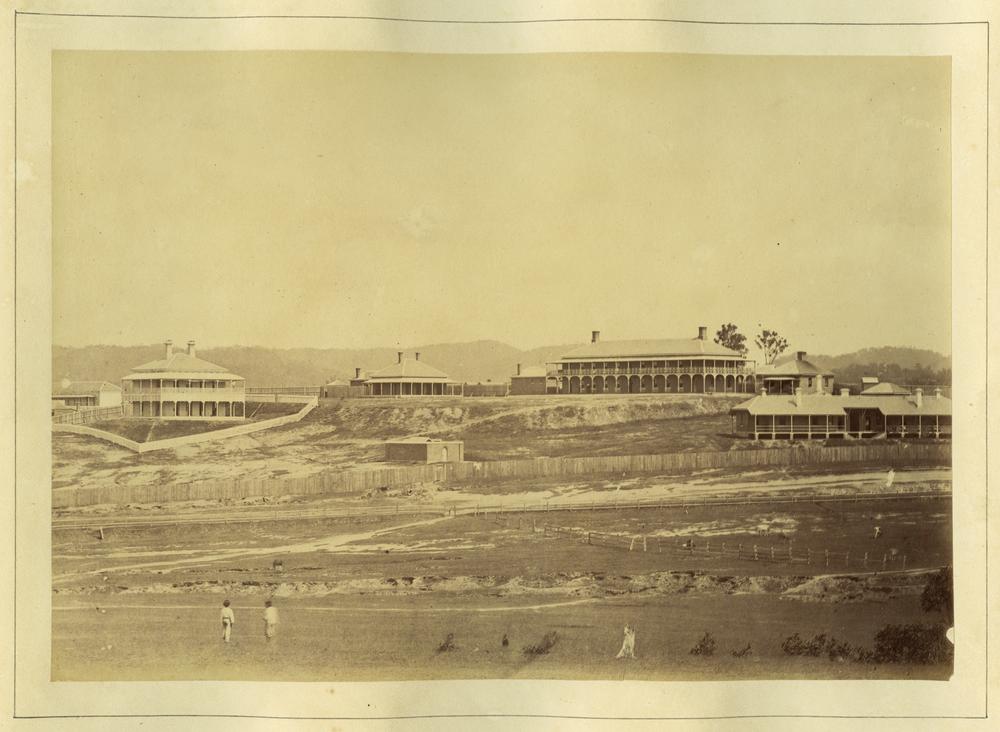 |
| Early picture of Victoria Barracks in 1868, taken from Roma Street |
 |
| Australian Aboriginal woman and child, Queensland, circa 1870, National Library of Australia |
 |
Archer family in front of the Military Barracks, Brisbane, circa 1870. Mr Archer was an inspector with the Bank of New South Wales in Brisbane
In 1872 the General Post Office was built in Queen Street, Brisbane. Before the post office was built, the Women's Female Factory had existed on this site. This historic building, which was constructed about 1829, was demolished in 1871. |
 |
| Brisbane, QLD, Circa 1870 |
 |
| A glimpse of early Brisbane shows the women convicts' compound which stood where the present Brisbane GPO is. Telegraph (Brisbane, Qld. : 1872 - 1947), Wednesday 25 October 1944 |
 |
| The first post office located at the Queen Street site which once hosted women convicts was demolished in 1871, Sunday Mail (Brisbane, Qld. : 1926 - 1954), Sunday 18 April 1937 |
 |
| Group of Aboriginal Australian people, Brisbane, circa 1870, National Library of Australia |
 |
| Brisbane town, circa 1870. State Library of QLD |
The rugby union association in Queensland was founded in 1883, after a meeting at the Exchange Hotel in Brisbane.
 |
| Queensland Rugby Union Team who played New South Wales in an Intercolonial Match, ca. 1883, State Library of Queensland |
 |
| Adelaide House or The Deanery, Ann Street, Brisbane, ca. 1882, after the excavations of Adelaide Street, State Library of Queensland. Adelaide House was rented by the government for £350 per year, as the Governor's residence in 1859 |
Flooding |
Style of first ambulance litter used in Queensland. This formed part of the Brisbane Ambulance Centre's plant.Morning Bulletin (Rockhampton, Qld. : 1878 - 1954 |
The 1893 Brisbane flood occurred when the Brisbane River burst its banks on three occasions in February 1893.
 |
| Queen Street, Brisbane, QLD. One of the major roads in Brisbane, after the 1893 floods. Residents are seen rowing boats to move about due to the flooding |
 |
| Flooding of the Brisbane River, QLD, in 1893. Ship Inn hotel in the centre front of the photograph. |
Transport
In 1885, horse drawn trams began service in Brisbane. Electric trams were introduced in 1897.
 |
| The First Horse Tram in Brisbane, c1880, Queensland State Archives |
 |
| Horse tram at the northern end of the first permanent Victoria Bridge, c. 1890, Library QLD |
 |
| Victoria Bridge in Brisbane, Qld - 1883, Aussie Mobs |
 |
| Charlotte Street, Brisbane, 1893 floods, Queensland State Archives |
Business and Pleasure
The Brisbane Cricket Ground was first used as a cricket ground in 1895, with the first cricket match played there in December 1896.
 |
| Saloon Car in Queen Street, Brisbane, QLD, 1898, SLQLD |
 |
| Butter factory, Stanley St, South Brisbane, QLD, Queenslander (Brisbane, Qld. : 1866 - 1939), Saturday 8 December 1900 |
 |
| Astill & Freeman's leather factory, South Brisbane, 1900, State Library of QLD |
 |
| Workers in a boot making factory, South Brisbane, QLD, 1900, State Library of QLD |
 |
The Longreach Hotel, Brisbane, c 1900, "Longreach, the site of the first Anglican Church in Brisbane. The building was remodelled in 1908."Queensland State Archives
|
Central Railway Station in Ann Street, Brisbane, was completed in 1902. The same year that Brisbane officially became a city.
 |
| Sydney Mail and New South Wales Advertiser (NSW : 1871 - 1912), Wednesday 1 June 1904 |
 |
| Looking east to the main station entrance across Ann & Edward Streets from the verandah of the People's Palace in 1911, State Library of Queensland |
Tom Petrie's Reminiscences
Many details about the Aboriginal people and the early convict settlement of Brisbane were recorded in a book called
Tom Petrie's Reminiscences of Early Queensland, which was published in 1904.
Petrie, who was born in Scotland, moved to the Moreton Bay penal colony, which was to become Brisbane, with his family. Accepted by the Aboriginal people, Petrie learnt the Aboriginal language and spent much time with them. His book also recalls the
life of convicts in chains and crowds watching the government hangings.
 |
| Thomas Petrie (31 January 1831 – 26 August 1910) |
 |
| Indooroopilly ferry crossing the Brisbane River, Brisbane, QLD |
 |
| A residence in Adelaide Street, Brisbane, QLD. (The original photograph caption makes reference to the residence being near the Inns of Court.) 1912. Queensland State Archives |
The University of Queensland, which was the first university in the state, was officially founded on April 16, 1910.
 |
| Inauguration procession at the founding of the University of Queensland, Brisbane, 1911, SLQLD |
 |
| Servicemens' wedding at St Lukes Church, Charlotte Street, Brisbane, 13 December 1917. State Library of QLD |
War and Peace
Charles "Smithy" Kingsford Smith, was born in 1897 in Brisbane. In 1928, along with Australian pilot Charles Ulm and two American radio operators, he completed the first trans-Pacific flight in a three-engined Fokker plane, the "Southern Cross". A huge Brisbane crowd greeted the plane which landed at Brisbane after flying from San Francisco.
 |
| Arrival of Charles Kingsford Smith in "Southern Cross" at Eagle Farm after first crossing of the Pacific Ocean from San Francisco, 9 June 1928, Queensland State Archives |
1930s
 |
| Queen Street, Brisbane, QLD, looking south west, March 1934. Queensland State Archives |
 |
| Making a tackle in a game of Rugby, Brisbane, Photographer: George Jackman for Queensland Newspapers Pty Ltd. Date: 6 Aug 1938 |
War Again
General Douglas MacArthur, the Supreme Commander in Chief of the Allied Forces in the South West Pacific Area arrived in Brisbane and
occupied offices in the AMP building in Queen Street, Brisbane, in 1942.
 |
| World War 2 era photo of Australian soldiers marching down Queen Street in Brisbane city. The building on the left is on the corner of Queen and Edward Streets and is now known as Macarthur Central, named after US General MacArthur. Aussie~mobs |
 |
| Tanks rumbling through Queen Street, Brisbane, QLD. Sunday Mail (Brisbane, Qld. : 1926 - 1954), Sunday 4 July 1943 |
About 200 air-raid shelters were built in the Brisbane city centre, and about 20 still exist.
 |
| Air raid shelters on Ann Street, Brisbane, QLD, 1942 |
 |
| Interior view of Thomas Brown's cloting factory. The machinists are using Singer machines and are seated at long work benches., circa 1943, SLQLD |
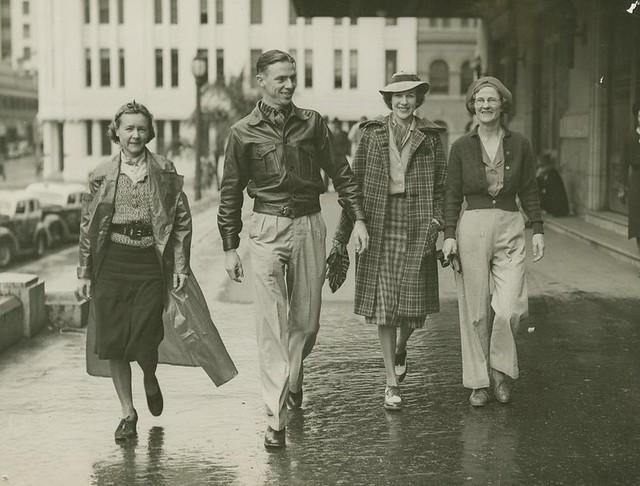 |
| From left: H. Clark, G. Pearce, B. Price and L. McNought preparing to leave on their outing to Stradbroke Island, in 1940. State Library of Queensland |
 |
| American G.I.s on the back of a Castlemaine Brewery truck in Charlotte Street, Brisbane, 1942, State Library of Queensland |
 |
| Dreadnoughts and other trams in Queen Street, Brisbane, QLD, in 1947 |
1950s
 |
| Section of the main showroom inside F. W. Nissen jewellery store in Brisbane, Queensland, ca. 1950, State Library of Queensland |
 |
| Courier-Mail (Brisbane, Qld. : 1933 - 1954), Monday 29 January 1951 |
 |
| Adelaide Street, Brisbane between Creek and Edward Streets, Brisbane, 1952, Queensland State Archives |
 |
| Cartographic Branch, Survey Office, Lands Department, Lands Department, Brisbane, 1953, Queensland State Archives |
 |
| View from above of rows of timber houses with outhouses built by the Queensland Housing Commission in Norman Park, Brisbane, Australia around 1950, State Library of Queensland |
 |
| Anzac Day veterans of the Mons battle of 1914 march through Brisbane, circa 1954. State Library of QLD |
 |
| Trams in Adelaide Street, Brisbane, QLD.The street is decorated for the arrival of Queen Elizabeth II |
.jpg) |
| Unidentified Location: Brisbane, Queensland, 1952 |
1960s |
| Members of 8 platoon, C Company, 6th Battalion, Royal Australian Regiment, in the battalion lines at Enoggera, Queensland, prior to deployment to Vietnam in May 1966. From left: 2781803 Private Rodney Cox of Ganmain, NSW; 2781794 Private Gordon Stafford of Gunnedah, NSW; 2781823 Private Neil (Pop) Baker of Newcastle, NSW; 2781790 Private Mark (Scrub) Minell of Moree, NSW; 2781809 Private Graham Irvine of Coolamon, NSW. All five men were called up in the first intake of national service in July 1965, Australian War Memorial collection |
 |
| Brisbane, QLD, had the Warana Festival, a great annual Spring extravaganza which began in 1962 and included a 2 hour parade through the city streets featuring decorated floats, marching girls, entertainers, and bands, under the blue Brisbane skies. Warana, which is an Aboriginal word for "blue skies", endured until the early 1990s, Queensland State Archives |
 |
Queen St, Brisbane circa 1967. Student protest march. 114 Arrested in Street Battle Queensland State Archives The Victoria Bridge over the Brisbane River, opened in 1969, the third permanent crossing erected at this location. |
1970s
Indooroopilly Shoppingtown (now Indooroopilly Shopping Centre) opened in 1970. At the time, it was dubbed the largest shopping mall in the Southern Hemisphere.
 |
| Indooroopilly Shoppingtown, Brisbane, QLD, c 1976, Indooroopilly Shoppingtown (now Indooroopilly Shopping Centre) opened in 1970. At its opening, it was reputedly the largest shopping mall in the Southern Hemisphere. |
 |
| The new Executive Building at 100 George Street was completed in 1971. It closed in 2016 and was demolished in 2017. This view is looking up Mary Street. Queensland State Archives |
1980s
The Commonwealth Games were held in Brisbane from 30 September to 9 October 1982.
 |
| Opening ceremony of the 1982 Commonwealth Games in Brisbane with mascot Matilda winking to the crowd, 30 September 1982, Brisbane City Council |
 |
| Queen Street, Brisbane c1981, Queensland State Archives |
World Expo 88 was held in South Brisbane between Saturday, 30 April 1988 and Sunday, 30 October 1988.
1990s
2000s
 |
| Looking down the flooded Margaret Street looking towards Edward Street and the Port Offic, Brisbane, QLD, Andrew Kesper. The Brisbane River banks broke on the 11th of January 2011, with approximately 20,000 houses affected by flood waters. Among the worse hit areas were St Lucia, West End, Rocklea and Graceville. |
The Morton Bay settlement was selected as the capital, developing within four decades from a military outpost into a busy port and business district, with some impressive buildings, despite the lack of town planning.
What Remains From The Convict Years
Sadly, only two buildings survive today from Brisbane's convict years: the Commissariat Store near the Brisbane River and the tower mill in Observatory Park adjacent to Wickham Park. However, Brisbane is famous for its Queenslander style residences, which can be found in some suburbs.
 |
| Commissariat Store, 115 William Street, Brisbane. Built by convicts in 1829 |
Demolished
There are also some outstanding buildings from the 1800s in the Brisbane city centre. However, the corrupt Bjelke-Petersen government demolished
many historic buildings, notably, some during the night, like the Bellevue Hotel. About 66 buildings of heritage value were destroyed, never to be replaced.
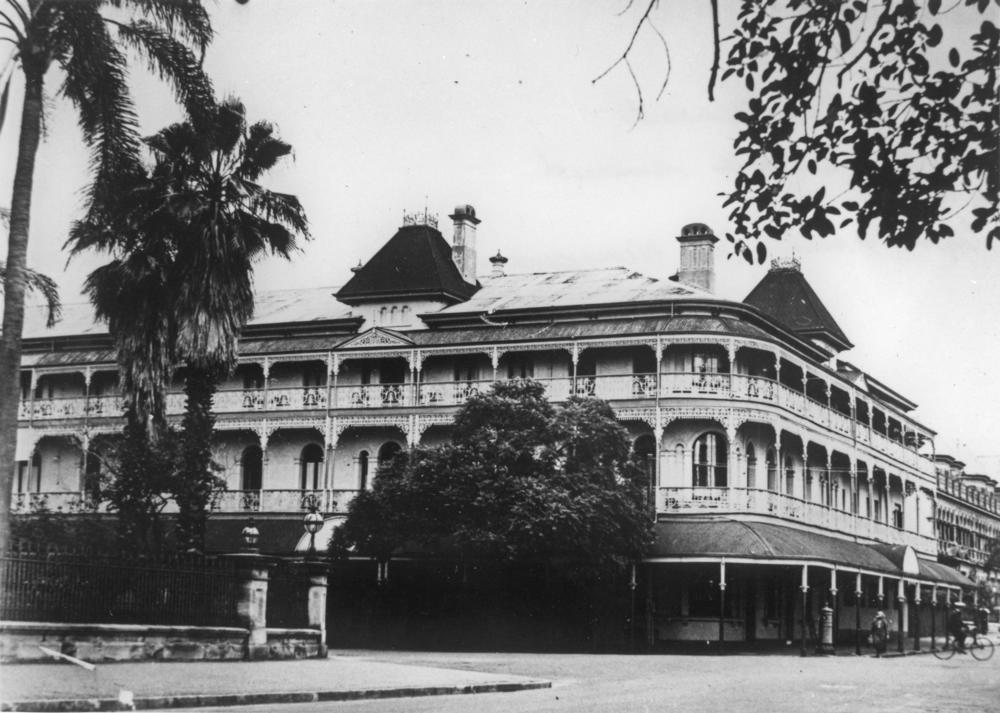 |
| Bellevue Hotel, built 1885-86 (photo 1933) |
 |
| Her Majesty's Theatre, Brisbane, built 1888, was earmarked for demolition by the Kern Corporation. Despite community protest, was demolished on 23 October 1983 |
Around Brisbane
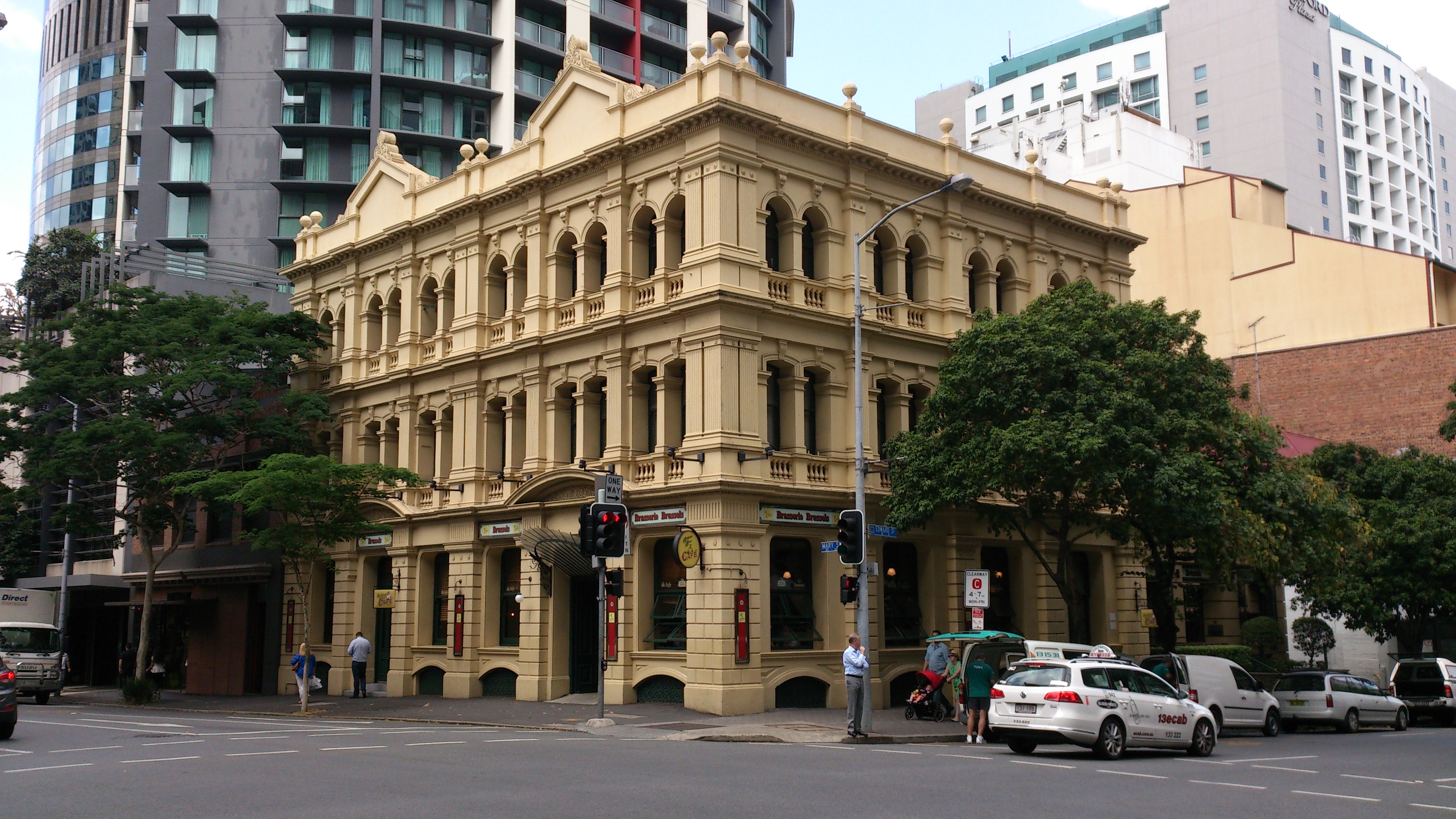 |
| 169 Mary Street, Brisbane CBD. Built from 1887 to 1888 |
 |
| Government House Brisbane, Queensland, designed by Benjamin Backhouse and built 1865 |
.jpg) |
| Allgas Building. Brisbane, QLD, Circa 1885 |
 |
| Athol Place 303 Wickham Terrace, Brisbane, QLD |
 |
| A large Federation style suburban Queenslander in New Farm, Brisbane, QLD |
 |
| Bess Street Brick Cottages at Windsor, Brisbane. QLD, Circa 1880 to 1930s |
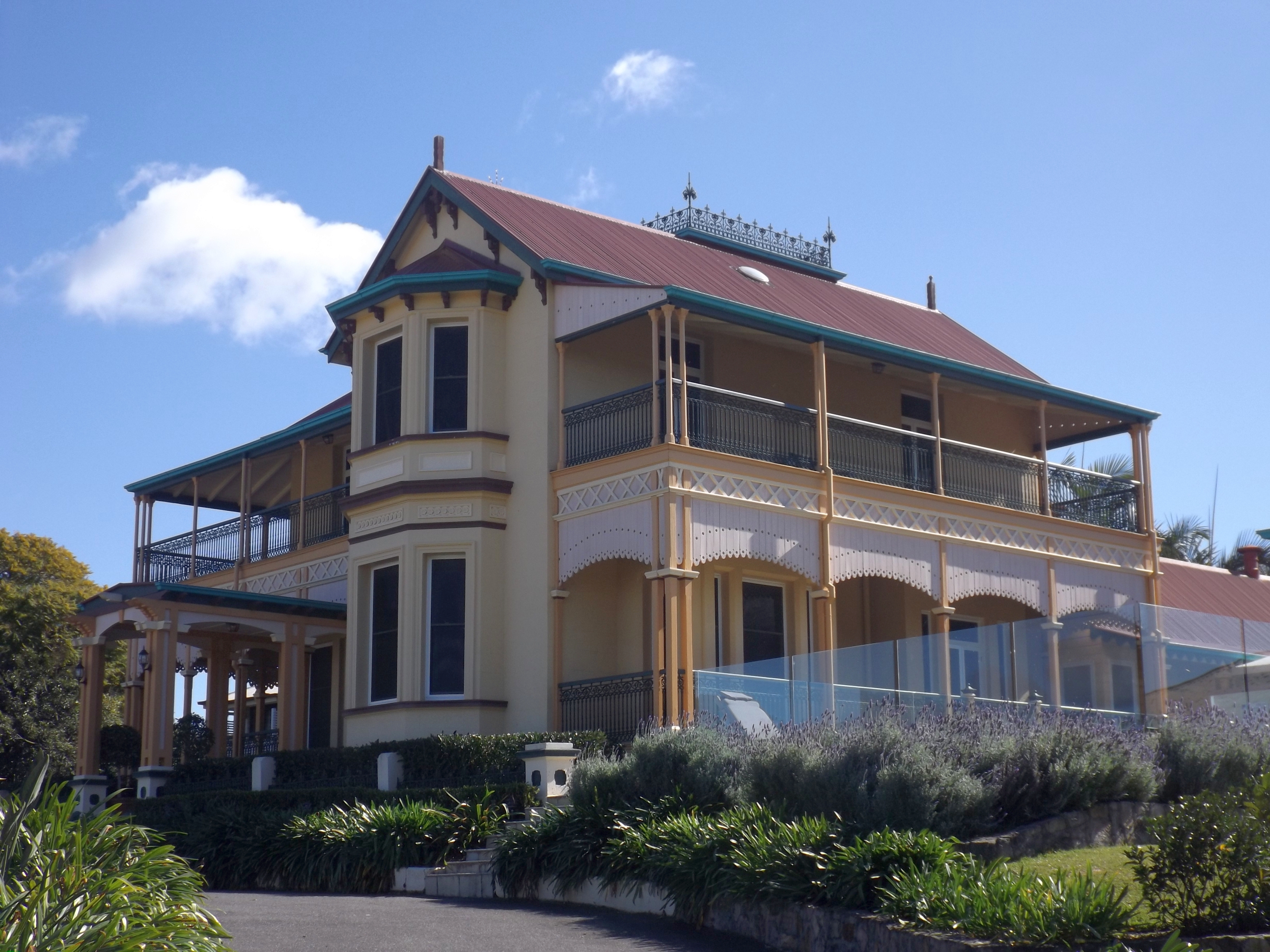 |
| Boothville House at Windsor, Brisbane. QLD, Built from 1887 to c. 1900. |
 |
| Chelmer Police College. Built from 1900 to 1970, Brisbane, QLD |
 |
| Coronation Hotel, South Brisbane. Built in 1891 |
.jpg) |
| Glenugie, New Farm, City of Brisbane, QLD. Built from 1884 to 1885 |
.jpg) |
Roma Street, Brisbane City. QLD. Circa 1877
|
 |
| The Mansions in Margaret Street, Brisbane. QLD. Built in 1889 |
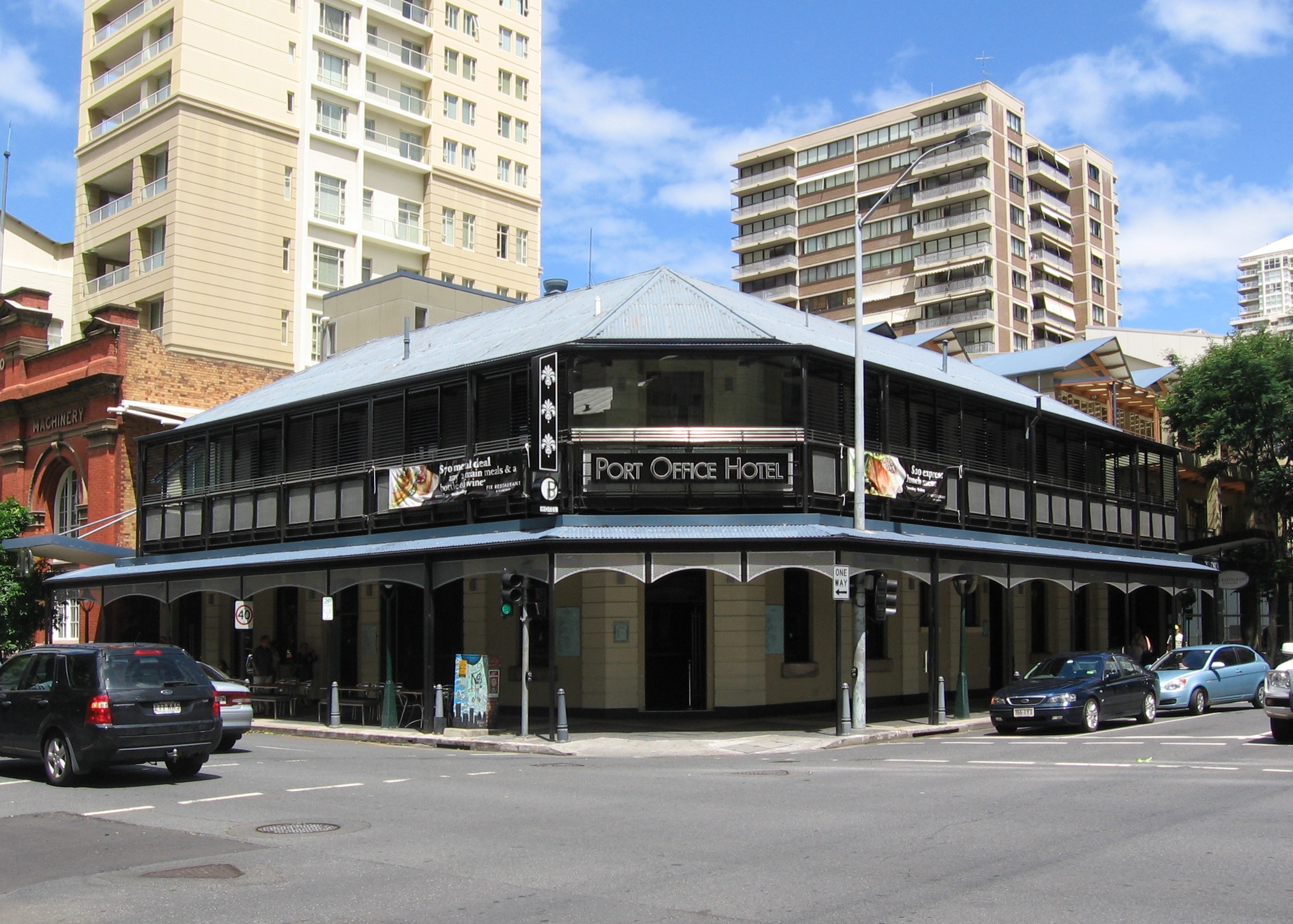 |
| Port Office Hotel. Brisbane, QLD. Circa 1876 |
 |
| Smellie & Co at 32 Edward Street, Brisbane. QLD. Built from 1895 to 1896 |
.jpg) |
| Toorak House, 28 Annie Street, Hamilton. Brisbane, QLD. Circa 1865 to 1915 |
 |
| Moorlands Victorian villa. Brisbane, QLD. Circa 1880s |
 |
| The Ross Roy villa, now owned by St Peters Lutheran College, was built in 1897; owned originally by tea merchant, Daniel Collings. Located at 60 Harts Road, Indooroopilly, Brisbane, QLD |
.jpg) |
| Greylands, circa 1876, at 47 Dennis Street, Indooroopilly, Brisbane, QLD |
 |
"Broadhurst", 138 Flinders Parade, Sandgate, Brisbane, QLD, circa 1900-1901
|
 |
| Former St Martin's War Memorial Hospital next to St John's Cathedral, Brisbane, QLD. Built 1922 |
 |
| Ballow Chambers, Brisbane, QLD, was was built in 1924-26, |
 |
| National Australia Bank at 308 Queen Street, Brisbane, QLD. built from 1881 to 1924 Kgbo |
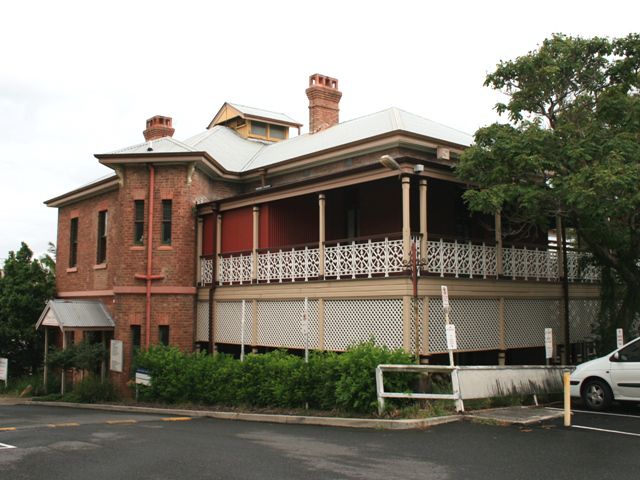 |
| Brisbane General Hospital Precinct - Lady Norman Wing, was constructed in 1895, QLD |
 |
| Brisbane General Hospital Precinct - Edith Cavell Block, constructed in 1922, QLD |
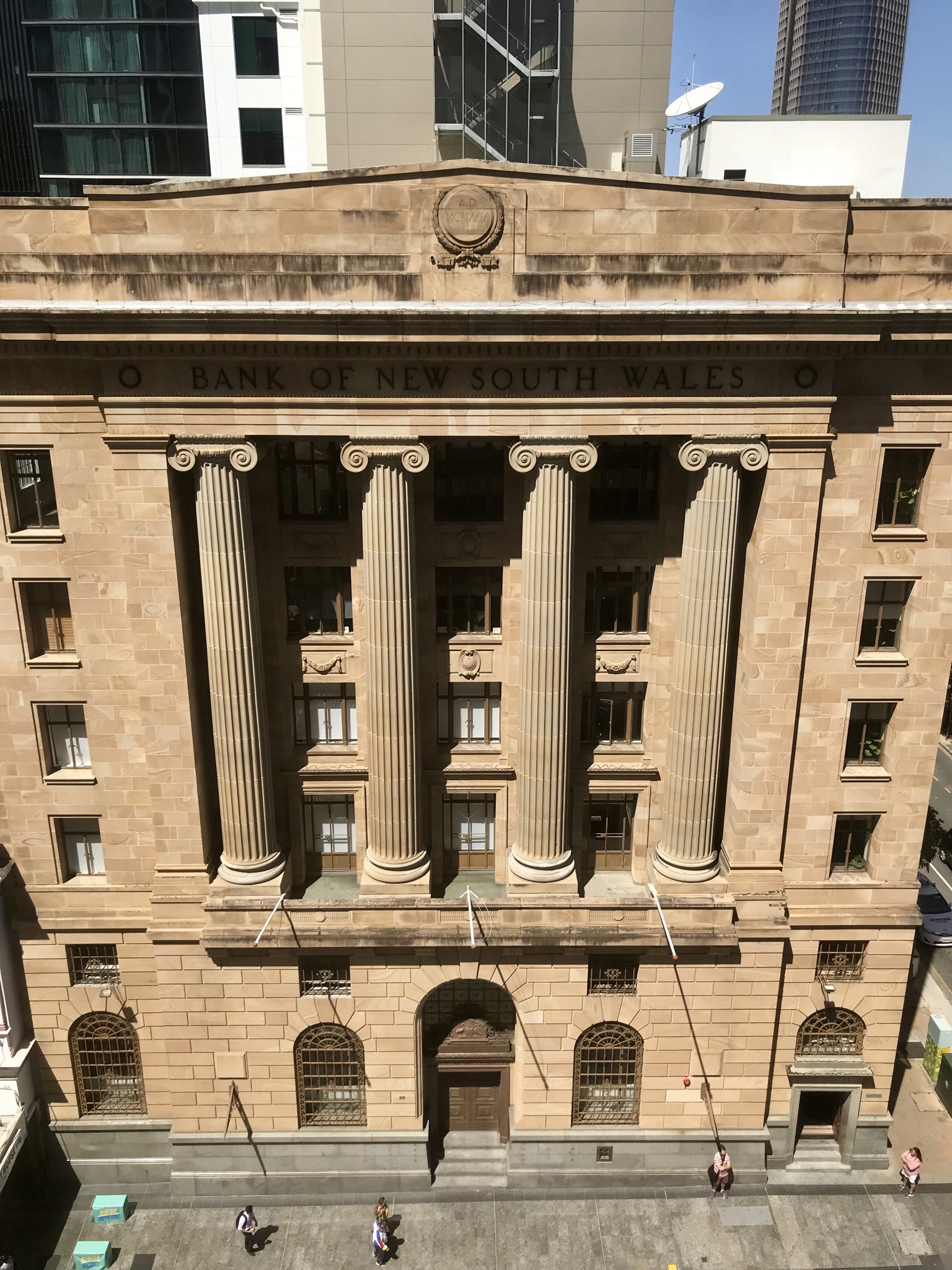 |
| Bank of New South Wales, located at 33 Queen Street, Brisbane, QLD, built from 1928 to 1930 |
 |
| Brisbane City Hall, Brisbane, QLD, was opened in 1930 |
 |
| The Old Windmill, Wickham Terrace, Brisbane. QLD.The oldest convict-built structure surviving in Queensland. Constructed in 1828 |
 |
| The Anglican Deanery, which was built for Dr. Hobbs, the first Government Medical Officer, who arrived in Brisbane from England in the Chaseley in 1849. It was from here that the new State of Queensland was proclaimed, Brisbane QLD, State of Queensland: Queensland Heritage Register: The Deanery (2008). Brisbane, QLD |
Things To Do and Places To Go
Convict Trail Redcliffe
ZigZag Street (1996), a novel by Nick Earls, is about Richard Derrington a 28 year old corporate lawyer in Brisbane struggling to cope after his girlfriend, Anna, has left him. He lives on Zig Zag Street in the suburb of Red Hill, Brisbane, Queensland in his grandmother's former home.









































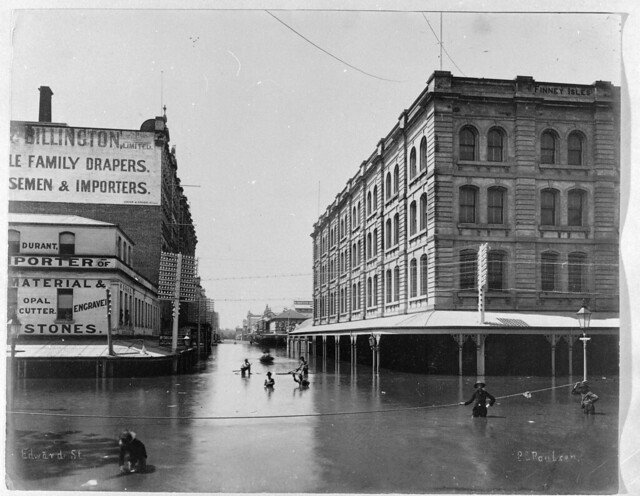











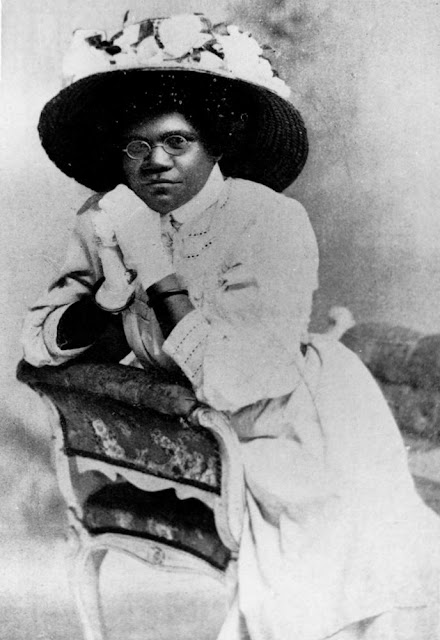
























.jpg)





















.jpg)






.jpg)
.jpg)


.jpg)

.jpg)
















